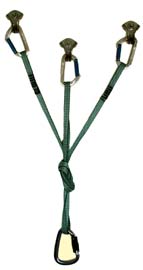WEB-O-WHAT?
THE MOUNTAIN TOOLS® WEB-O-LETTE® - AND
WHERE IT CAME FROM
A
sling with an eye in each end is nothing new - loggers
call them "chokers" (and hitch them around their trees),
crane operators call them "lifting slings" (for hoisting
pipes and the like), and in 1974 Bill Forrest made
them from 1" military spec. webbing and called them
"Rabbit Runners" (bunnies have two ears don't they?)
and suggested they be used for climbing. Bill's invention
was short lived however - most climbers did and still
do use web loops (called runners) for extending their
carabiner clip attachment of climbing rope to piton,
bolt, nut or cam. In order to be strong, these runners
had to be made from rather heavy and bulky nylon tubular
webbing which was a convenient by-product of WWII.
Many years later - in the late eighties (with the
growth in popularity of recreational climbing) special
webs were evolved with hybrid material components
- like Spectra - which allowed lighter and more compact
patterns to be woven specifically for the climbing
market. This new material coupled with advances in
sewing techniques and thread all but have retired
the "traditional" 1" tubular material - which today
seems heavy and "old school" and better suited for
industrial purposes. One such material was Mountain
Tools® Ultratape™ - an 11/16" wide hybrid of Nylon®
, Spectra® and Dacron reg. The key design parameter
of Ultratape™ is the balance of these components for
optimum climbing performance - strong and light with
super abrasion resistance as well as high strength.
Ultratape™ is the near perfect material for our Web-Gear™
- runner loops, Snake Runners (sounds stronger than
Rabbits eh?) and of course the Webolette® Anchor Sling.
In fact it is the only hybrid Spectra® web - from
any manufacturer - that can be safely tied in a loop
with the water knot (ring bend) or grapevine (double
fisherman's) knot. Good to know your emergency rappel
sling will hold 5,000 lbf plus!
Back
in the 70's and 80's I did my best to become a full
time climber and also had the privilege of serving
on a Mountain Rescue Association team - where EVERYTHING
was equalized, backed up and multi-point anchors were
our way of life. Rescue loads included big guys (the
rescuers), even bigger patients (who got a ride in
the litter) and tons of equipment. The effective but
inelegant sling of choice was the bowline-on-a-bight
with two tails serving as master load points. This
usually was made from 7/16" rope - about 30 to 50
feet - and we used two for redundancy! The principal
was sound but the weight and bulk unacceptable for
climbing. Enter the cordelette - an import idea of
Eupopean invention that relys on rather standard (and
still good) nylon accessory cord. I can't rightly
say when I saw my first cordelette but it was probably
in the mid eighties... I remember thinking it was
more a mountaineering sling than for rock climbing...
but that was the opinion of a hard core Yosemite rock
climber.
Flash
forward - 1995 - over 30 years of Mountain Tools®
experience (and 40 years of sewing web - harnesses,
runners, etriers) and we needed a better anchor sling!
A couple of our staff team used cordelettes and recited
their virtues (cheap, adaptable,) and vices (bulky,
gangly, knot gets in the way). We were challenged
and had to do better! For guiding I wanted something
easy to teach, easy to verify (at the belay station)
and very easy for clients to dismantle, unknot and
rack on their harness. We futzed with straps and buckles
(inspired by Jeremy St. Ours of Solstice), knotted
accessory cord in every conceivable conflabragation
and finally - after removing all the unnecessary parts
- settled on the Webolette® - an elegant , abbreviated
version of the Euro Cordelette (hence our trademark
name). Our team was psyched - we had something that
was simple, really worked, would save us time and
hassle on each pitch and would be a real service to
climbers everywhere.
The
key to the current Webolette® is the 12 mm Utratape™
Lite material - a blend of Dyneema and Nylon , how
it is sewn (much more than meets the eye) and the
documentation that accompanies the product - with
full description, instruction, do's and don'ts and
general anchor smarts. It is the standard SERENE (Secure,
Equalized, Redundant, No Extension) anchor system
taught by us American Mountain Guides Association
professionals. We encourage climbers to embrace our
mantra: V-W-8 On Belay! Read up on the reviews ( http://www.gearreview.com/webolette.asp
) and
if you have questions about gear, building anchors
or anchor slings, give us a call
(831 620-0911) or "Ask the Toolman" we always enjoy
hearing from climbers - like you!
Best Climbing,

Larry Arthur, Mountain Tools